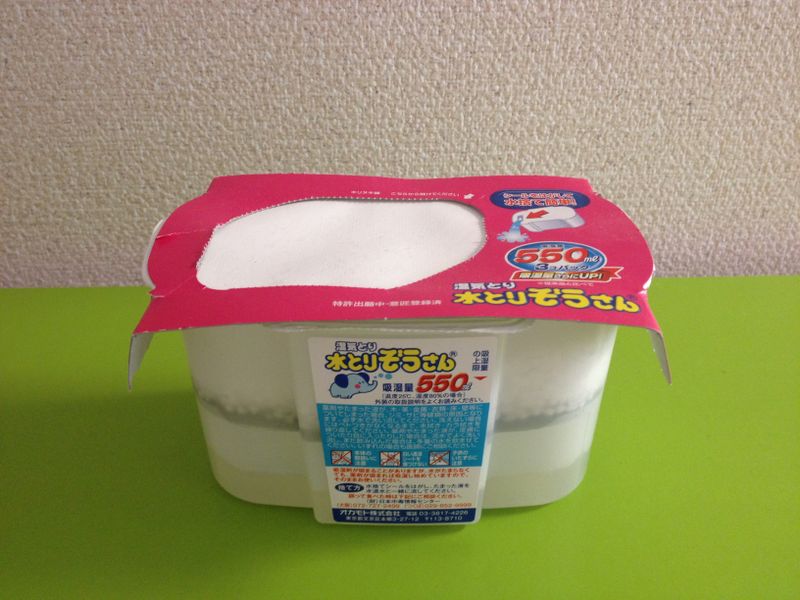Jun 16, 2018
Managing humidity and mold in Japan's rainy season
In my 27 years on this lovely Earth, I'd only ever dealt with mold once. I was 23, living in an ancient, partially renovated Victorian terrace house in Melbourne with this weird, random inner bathroom that had absolutely no windows or form of ventilation. Being a sharehouse, the shower ran hot at all hours of the day, and soon the roof began to darken with spots of mold. Luckily, Melbourne's climate is ordinarily cool and dry, so all we needed was a splashing of mold killer on the ceiling and a DIY ventilation fan and we were back in business.
I cringe to think what that bathroom would have looked like if it was in Japan.
These days I live in a 25m² studio apartment with my husband and my cat in Setagaya. We've been in this apartment just on six weeks, and in that time we've witnessed the stark juxtaposition of lovely, sunny early May, to the cloudy throes of June's rain season.
And, now, I have my first serious mold problem on my hands.

The minute I saw the first spots of green, I was horrified. I jumped straight onto Google, researching whatever chemicals were needed to rid my house of this evil. After a good two hours of research, I soon realised that this was:
a) a fairly common problem in Japan;
b) not a huge deal; and
c) something that could be easily managed with a good clean of impacted areas, a few products, and a mold prevention plan.
*Friendly tip: Don't do what I did and read articles about the dangers of mold. I am now scarred for life. Whilst, yes, mold can be dangerous, if it was as hazardous and insidious as what many websites say then, well, we'd probably all be dead. But, as you know, we're not all dead (yay us), so friendly reminder to stay on track if you're doing research!*
Thoroughly clean affected areas
Where you've found spots of mold, the first thing you'll need to do is remove it, pronto. You can pick up mold killing spray at Japanese drugstores and supermarkets, the most common being Kabi Kiraa (カビキラー) which literally just means mold killer (eee, I imagine little chemical men running around the walls shooting at little green mold spores, so cute). Kabi Kiraa has bleach in it, so be really careful what you spray it on. Also, open up the doors and windows and wear protective gear (like masks and gloves) so you don't get any dangerous bleach fumes all up in your face.
If you're looking for something a little more natural, spray vinegar on the affected area and leave for an hour before wiping with water. If you, like me, find the smell of vinegar a little rude, you can add essential oils or baking soda to reduce the pungency. Vinegar can also prevent mold growth if you spray it on problem areas, such as walls in dark, damp places, so spritz it sparingly from time to time, especially during a cloudy, rainy week.
Tea tree oil will also get the job done and done good. As a powerful antiseptic and disinfectant, it will kill mold and leave a pleasant eucalyptus-type aroma in the air. Personally, I love tea tree oil and use it for everything. Getting a pimple? Tea tree oil. Burnt my hand on the toaster? Tea tree oil. Bit of dandruff? Tea tree oil. Boyfriend broke your heart? Tea tree oil. I'm all about it.
Some websites also recommend hydrogen peroxide as a great spot cleaner given its effervescency (is that a word? It is now!) but I've never tried it before so can't comment.
Once you've killed the mold, here's how to prevent it from growing back:
Get yourself a mold prevention plan
Yeah, I know, it sounds about as fun as a pension planning seminar, but it's important that you make it difficult for the mold to grow back. Not only is it bad for your health (again, don't Google it. But trust me: bad for the ol' lungs), but if you're renting you might be up for cleaning or damage fees if it gets out of control.
Invest in a dehumidifier
Depending on how prone your home is to mold, you can choose from a machine dehumidifier (joshitsuki 除湿器), or little disposable dehumidifiers (shikketori 湿気とり). For all my time on earth, I had always wondered what dehumidifiers were for (I always thought they were to help people sleep better or something). Now, I know what those babies are all about, and tomorrow I'm off to get myself a dandy little Sharp dehumidifier I found on Craigslist. You can get them at places like BIC and Yodobashi, but if you're poor (like me) have a look at online classifieds and sayonara sales for some cheapies.
I've also purchased some disposable dehumidifiers — you know the ones:

I got mine from the local drugstore in a pack of 3 for ¥138. You'll notice on the nearby shelves there are also charcoal mats for drawers, absorption pads, and other moisture removing products, so stock up if you need to. I've chucked a few of these under the bed and in the cupboards.
Get that air moving!
One thing that mold loves is dank, stagnant, motionless air. Get that airflow moving by opening up your doors and windows and investing in a fan. If you've got an air-conditioner, even better (and lucky you!) I know that it gets chilly in autumn and winter, but it's so important that you get that fresh air moving for a few five minute periods throughout the day. Also, your lungs will love you for it.
I'm not your mum, so I'm not going to tell you to use the ventilation fan when you're taking a shower. But seriously, do as your mum says. Also, once you've finished in the shower, give the whole area a spritz of cold water to reduce the temperature of the area.
Clean up and prevent condensation
When your apartment gets steamy at night and in the mornings, make sure you wipe down water that accumulates on the glass and in the door tracks/window sill. Otherwise, mold will start to grow in these tiny areas, fed by the dripping condensation.
Check the weather!
Your greatest ally is a sunny day and a nice breeze. When we're chanced with a dry, warm day, crack open those doors and windows and gulp down that fresh air!
If you've got any tips on mold, please let me know!
Hellooo! I'm Lisa from Melbourne, Australia. I moved to Tokyo in May 2018, moved back home in May 2019, and in February 2020 moved back to Tokyo again! Catch me on Instagram at @lisainjapan



4 Comments
helloalissa
on Jun 17
Yay tea tree oil! I got some with my Amazon credit & put a little in a spray bottle with vinegar for cleaning all the things.
Lisagoestotokyo
on Jun 17
@helloalissa Yay that’s awesome! Tea tree oil will be my first purchase on Amazon too! I seriously use it for everything haha
dipta
on Jun 18
All set for the rainy season then, haha! I wish we had more space for a laundry dryer as well... May I ask, how do you use tea tree oil for dandruff?
Lisagoestotokyo
on Jun 18
@dipta hey dipta! Oh I wish we had a dryer too! We picked up the dehumidifier yesterday. Usually in the mornings our windows are covered in condensation, but today, nothing! I never thought I'd be so excited about a small machine haha Of course! I usually mix two teaspoons of coconut oil with three to six drops of tea tree oil. Then I massage it into the areas I get dandruff (usually my hairline) and leave it overnight. Just be careful that you don't add too much tea tree oil as it can really sting and dry out the area, that's why I like to mix it with coconut oil because it's so moisturising and has antibacterial properties too. I used to also buy a tea tree oil shampoo (in Australia it's called Thursday Plantation Tea Tree Oil Shampoo) which I've just noticed is on Amazon and it ships to Japan (yay!)